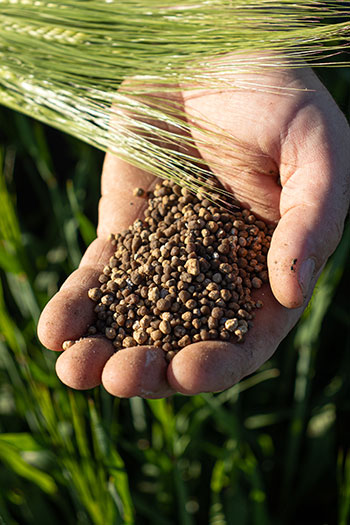Compared to sorghum, chickpeas can convert additional phosphorus and potassium more efficiently from applied fertilisers into grain yield – a key difference that deep-banding nutrient research has illustrated.
For more than a decade, with growers, agronomists and Queensland Department of Agriculture and Fisheries researchers, the University of Queensland’s Professor Mike Bell has been assessing deep banding in GRDC-supported projects.
With both phosphorus and potassium immobile in the northern region’s clay soils, deep banding offers a way to ‘drought-proof’ soil nutrient supply. When crops dig deep for moisture, they will also have access to nutrients.
In Central Queensland, at sites with very low background phosphorus and potassium in both the topsoil and subsoil layers, chickpeas and sorghum have reacted differently in three main ways.
 The deep banding of phosphorus and potassium, like this granulated fertiliser, tackles two issues – these nutrients’ immobility in clay soils and the region’s reliance on stored soil moisture. Photo: Rowdy Travis
The deep banding of phosphorus and potassium, like this granulated fertiliser, tackles two issues – these nutrients’ immobility in clay soils and the region’s reliance on stored soil moisture. Photo: Rowdy Travis
First is chickpeas’ conversion difference. Professor Bell says this might be related to nutrient uptake timing relative to the yield-determining processes. Chickpeas are slower to develop an extensive root system and proliferate roots in phosphorus bands, but when they do it is closer to the onset of flowering and pod addition.
Conversely, sorghum quickly develops a root system that can rapidly exploit phosphorus or potassium sources. But this early nutrient access occurs long before grain yield determination and might not contribute as directly to yield development.
For example, additional tillers that typically form in response to improved crop phosphorus status might not have sufficient moisture, or nutrition, to deliver higher grain yields later in the season.
Professor Bell says the second point to notice is that ‘poor’ sorghum crops can acquire more phosphorus and potassium from soils with a similar low-nutrient status compared to chickpeas. This is consistent with more-frequent in-season rainfall events in summer, which either enhance root access to stratified topsoil layers or allow deep bands to ‘re-wet,’ providing prolonged root access.
The third point is that there was no evidence of phosphorus or potassium luxury uptake from deep-banded fertilisers of either kind – additional uptake meant additional yield.
This suggests that for every additional kilogram of phosphorus or potassium acquired in these soils, a relatively predictable grain yield increase will occur. The higher the seasonal yield potential, the greater the crop nutrient requirement.
“While handy for discussions with the bank manager, this finding does highlight that a single application of deep bands of phosphorus and potassium will not be enough to overcome the yield constraints that have developed from prolonged nutrient run-down,” Professor Bell says.
“This is consistent with other glasshouse and lysimeter studies and supports the hypothesis that a multi-pronged approach to restoring soil fertility is required.”
While deep bands can produce significant and economic yield responses, they need to be combined with fertiliser strategies that also ensure adequate phosphorus and potassium is maintained in the topsoil layers, so crops can utilise multiple soil layers when seasonal conditions permit.

























































